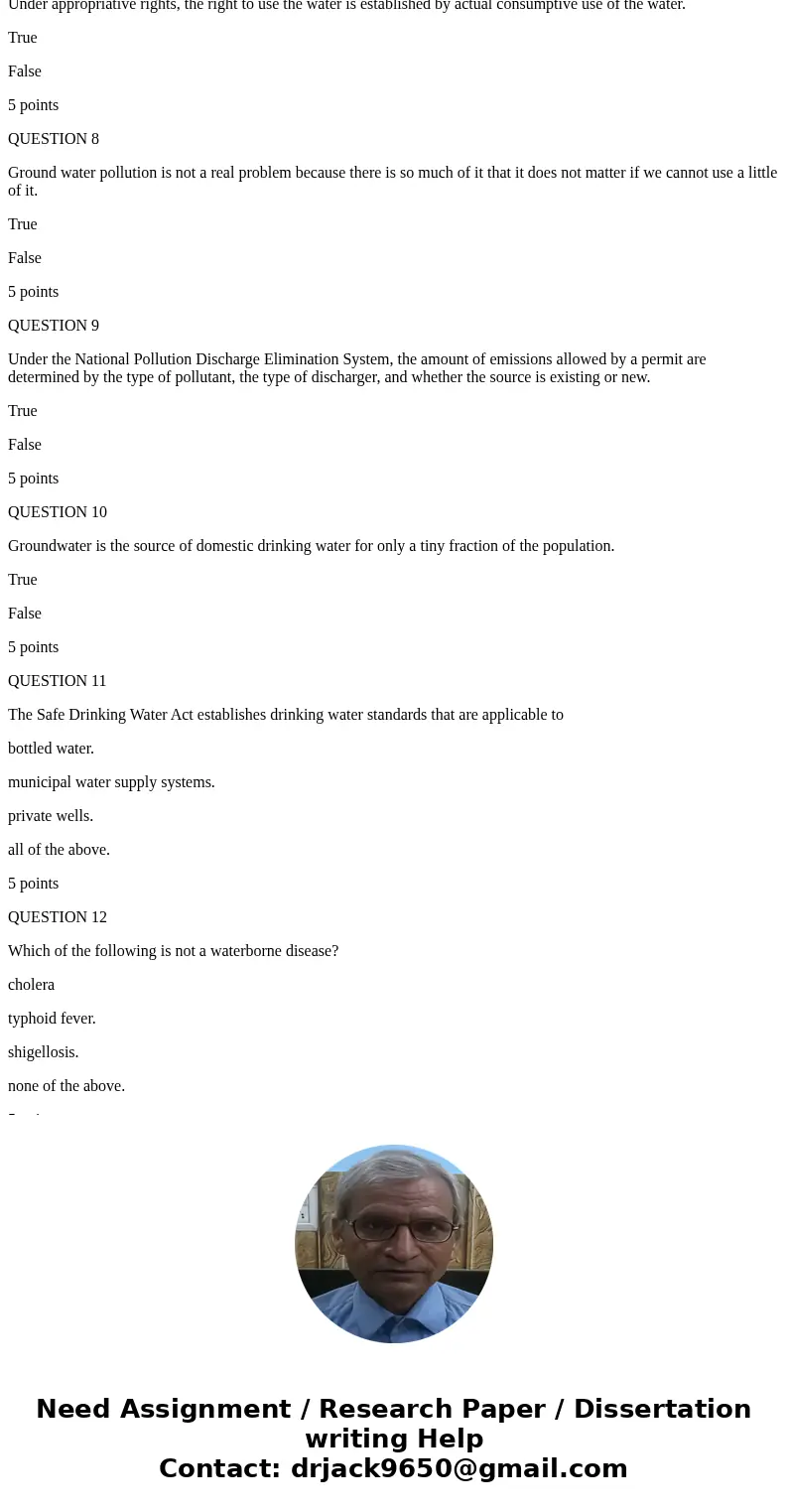Enforcement of the NPDES of the Clean Water Act is difficult
Enforcement of the NPDES of the Clean Water Act is difficult because the only penalties that may be assessed under the Act are civil fines of up to $25,000 per day per violation.
True
False
5 points
QUESTION 2
Nutrients are important to the health of a body of water and increase vegetation growth, thereby improving the quality of the water.
True
False
5 points
QUESTION 3
The primary source of pollution of streams today is industrial sources.
True
False
5 points
QUESTION 4
Pollution from nonpoint sources is easier to control than pollution from point sources because it\'s difficult to convince polluters to purchase and install expensive pollution control devices.
True
False
5 points
QUESTION 5
The goals of the FWPCA were to make all waters in the U. S. capable of sustaining fishing and swimming, and to totally eliminate pollutant discharges into navigable waters.
True
False
5 points
QUESTION 6
Point source pollutants are controlled under the FWPCA by a system of discharge permits that limit the amount of particular effluents that a plant can discharge into the water.
True
False
5 points
QUESTION 7
Under appropriative rights, the right to use the water is established by actual consumptive use of the water.
True
False
5 points
QUESTION 8
Ground water pollution is not a real problem because there is so much of it that it does not matter if we cannot use a little of it.
True
False
5 points
QUESTION 9
Under the National Pollution Discharge Elimination System, the amount of emissions allowed by a permit are determined by the type of pollutant, the type of discharger, and whether the source is existing or new.
True
False
5 points
QUESTION 10
Groundwater is the source of domestic drinking water for only a tiny fraction of the population.
True
False
5 points
QUESTION 11
The Safe Drinking Water Act establishes drinking water standards that are applicable to
bottled water.
municipal water supply systems.
private wells.
all of the above.
5 points
QUESTION 12
Which of the following is not a waterborne disease?
cholera
typhoid fever.
shigellosis.
none of the above.
5 points
QUESTION 13
Dischargers of conventional pollutants must meet
the most stringent pollution control technology standards.
the least stringent pollution control technology standards
BAT
none of the above.
5 points
QUESTION 14
Potential sources of contamination of groundwater DO NOT include
home septic tank systems
hazardous waste land disposal facilities.
underground storage tanks.
none of the above.
5 points
QUESTION 15
The MCL for drinking water
is determined by the EPA and is stricter than the MCLG.
takes into account the feasibility of attaining the standard.
must be developed for pollutants on the Contaminant Candidate List (CCL).
both a and c.
5 points
QUESTION 16
When states are designating streams and lakes for uses, the waterways that must become the cleanest are those designated for
recreational use.
public water supply.
agricultural use.
industrial use.
5 points
QUESTION 17
The technology-based standard for toxic water pollutants is
B.P.T. (Best Practicable Technology).
B.A.T. (Best Available Technology Economically Achievable).
B.C.T. (Best Conventional Control Technology).
none of the above (toxics cannot be emitted).
5 points
QUESTION 18
Which of the following was not one of the early acts designed to protect the water quality?
the Rivers and Harbors Act of 1899.
the Public Health Service Act of 1912
the Oil Pollution Act of 1924.
none of the above.
5 points
QUESTION 19
BOD:
is a measure of the oxygen demand of microorganisms in the water as they break down organic material.
which is too high will result in a loss of many species of fish, such as trout, which require a more significant quantity of dissolved oxygen than so-called \"garbage\" fish or bottom-feeders such as shad.
is one measure of how polluted a body of water is.
all of the above.
5 points
QUESTION 20
Nonpoint source pollution
is a greater problem than point source pollution in most states.
is more difficult to regulate because its source is often difficult to precisely identify.
is no longer a problem in most states.
both a and b.
5 points
Click Save and Submit to save and submit. Click Save All Answers to save all answers.
| A. | bottled water. | |
| B. | municipal water supply systems. | |
| C. | private wells. | |
| D. | all of the above. |
Solution
1) True. Enforcement of the NPDES of the Clean Water Act is difficult because the only penalties that may be assessed under the Act are civil fines of up to $25,000 per day per violation.




 Homework Sourse
Homework Sourse